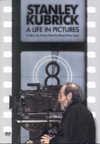Stanley Kubrick: A Life In Pictures (2001)
Warner Home Video
Cast:
Extras:
Rating:
Genius. Recluse. Tyrant. Director Stanley Kubrick went by many names during his amazing career. His cool, often unsympathetic eye gave the world such genuine original visions as "Paths of Glory, " "Dr. Strangelove, " "2001: A Space Odyssey," "A Clockwork Orange," "Barry Lyndon" and "Full Metal Jacket." A new documentary helps illuminate some of the mysteries of Kubrick’s life as well as overview his small but mighty output. After watching "Stanley Kubrick: A Life in Pictures," one more appellation may be added to an already prodigious list, but one I never would have expected: "family man."
Produced and directed by longtime Kubrick associate Jan Harlan, "Life" arrives with the remastered "Kubrick Collection" from Warner Home Video (the only way to own it is to buy the set). Harlan amassed an astonishing list of "witnesses" as well as drawing upon hundreds of stills, home movies, and never before seen footage illustrating Kubrick at work, at home and even at play. The documentary opens with a well-edited montage of clips and press clippings timed to Rossini’s "Thieving Magpie" overture used by Kubrick in "A Clockwork Orange," showing just mysterious he was to his fans and the media that loved/hated him. We see his childhood in New York City (his sister Barbara Kroner characterized him as "playful like the ‘Addams Family’"), his early success as a photographer for Look magazine, his entry into filmmaking and the features themselves. The interviews alone make up a virtual "dream team" of cinema. Directors like Woody Allen, Alex Cox, Paul Mazursky, Alan Parker, Sydney Pollack, Martin Scorsese, and Steven Spielberg share reminiscences and practically deconstruct scenes. Actors Tom Cruise (also the narrator), Keir Dullea, Shelley Duvall, Nicole Kidman, Malcolm McDowall, Matthew Modine and Jack Nicholson paint a picture of exhilaration and teeth gnashing that apparently occurred regularly on a Kubrick set. Collaborators such as Sir Arthur C. Clarke, Wendy Carlos, James B. Harris, Michael Herr, and Douglas Trumbull chart the contradiction of Kubrick’s exacting but free form filming style. Melding the professional with the personal, Christiane, Kubrick’s wife of forty-three years, daughters Anya and Katharina and brother-in-law Harlan also appear on camera.
The participation of Mrs. Kubrick, his daughters and the guiding hand of Harlan certainly indicate an authorized biography, but they don’t whitewash the less flattering aspects of Kubrick’s life. We see him just tear into Shelley Duvall on the set of "The Shining," frustrated that she is not giving him what he wants. (Michael Herr, Stanley’s writing partner on "Full Metal Jacket," talks about how Stanley did not always know what he wanted when filming, but definitely knew what he did not want.) Shelley states on camera, however, that she appreciated the experience of working with him. McDowall talks about how he expected the friendship they developed during the making of "Orange" to continue, only to find it completely severed once the film was completed. McDowall further states that his negative comments about Stanley stemmed from the betrayal he felt.
The most emotional recollections come from Christiane, explaining how they first met on the set of "Paths of Glory"(Stanley just kept smiling at her from across the room) and providing the most intimate insights of how he thought and really lived. In one home movie moment, Stanley’s young daughters chide him on how he directs everything, while off-camera he defends himself by saying he’s one of the most even tempered people around. They respond by rolling their eyes.
The exceptionally clean-looking transfer incorporates several aspect ratios. The interviews and specially shot footage is <$PS,letterboxed> at roughly 1.78 with the home movies and stills <$PS,full frame> and the film clips matted according to the estate’s wishes, meaning some titles are <$PS,widescreen> and some are not. The combination of solid colors, deep blacks and crystal-clear source elements make for an extremely watchable image.
Providing a <$DD,Dolby Digital> 5.1 soundtrack seems a bit perplexing, however. Dialogue driven (like most documentaries), the audio is mainly confined to the center channel. Only when playing clips of the films that underwent sound remixing for the new DVD release ("2001," "A Clockwork Orange," "Barry Lyndon") does the sound field open up. Other than that, the audio is crisp with ample levels and clear reproduction.
Whereas many documentaries attempt to make some interpretive statement about their subjects, "Stanley Kubrick: A Life in Pictures" simply unfolds the facts with minimal thematic intrusion. The resulting effect is Harlan accomplishes a Kubrick biography almost as if Kubrick himself directed it, probing the paradoxes of his life without any guidance as to "what it all means." Casual fans may want to rent the disc, but for die-hard Kubrick fans like myself, the DVD is indispensable.







